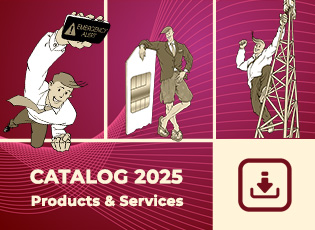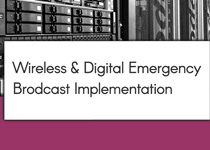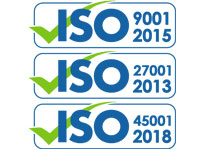Opencode Wireless Emergency Alerts - advantages and functionalities
Wireless emergency alerts are means of the public safety officials to warn the community for pending crises and imminent threats. Automated or custom wireless emergency alerts are distributed solely by the recognized governmental, regional, or tribular authorities and can be utilized during any type of natural or human-provoked disaster. These include severe weather conditions, earthquakes, volcanic eruptions, military conflicts, industrial collisions, infectious disease outbreaks, and others.
What types of technologies underlie the process of transmitting wireless emergency alerts, what is their brief history, and what are the fundamental advantages of using Opencode wireless emergency alerts for public safety purposes? Grasp all the important details on wireless emergency alerts in the following short paragraphs.
Wireless emergency alerts in a nutshell - fundamentals of the technology
The distribution of wireless emergency alerts is a complex technological process that can yet be explained in rather simplistic terms. Essentially, wireless emergency alerts are disseminated from a predetermined set of cell towers to any mobile device in a regionally targeted area. The process goes as follows:
- The parameters and content of the wireless emergency alerts are specified in a licensed alert management interface;
- The wireless emergency alerts are received and speedily processed by a cell broadcast center;
- Processed wireless emergency alerts are ultimately distributed to the Mobile Radio Access Network, following the relevant 5G/4G/3G/2G 3GPP standards;
- Handheld device owners receive their wireless emergency alerts just a few seconds after they've been sent out by the authorities.
Thus, different groups of citizens can receive brief SMS-like messages with warnings or safety guidance without having to download an app or subscribe to a service.
Receiving swift and timely wireless emergency alerts can be a life-saving factor in times of vicious and unexpected disturbances. Dependable wireless emergency alerts can provide public inclusion, communicate vital guidelines and instructions, and get people to respond adequately to the hazardous situation.
Wireless emergency alerts have a wide range of public applications
Wireless emergency alerts are implemented around all continents through different standardized systems and networks. Their potential applications vary throughout the globe, depending on the region's specifics and risk predispositions.
Contemporary wireless emergency alerts are first shown in Paris at the very end of the 20th century. In the following couple of decades, many countries and geographic regions have developed their own early warning systems that employ civilian wireless emergency alerts for specific purposes. Some of the examples include:
- The Indian Ocean Tsunami Warning System planned during a United Nations conference in 2005;
- The European Public Warning System - the standard wireless emergency alerts system accepted all around the European Union;
- J-Alert - a nationwide, satellite-based early warning system launched in Japan in 2007;
- The Commercial Mobile Alert System, operating within the borders of USA and currently known by the name of WEA (Wireless Emergency Alerts);
- The Earthquake and Tsunami Warning System, utilized by many countries with high seismic activity;
These are just a tiny part of the disaster management tools used around the planet. The Opencode wireless emergency alerts are compatible with a great number of standard public alert services and network entities, including EU-Alert, WEA, CMAS, ETWS, AMF, MME, RNC, and BSC.
Wireless emergency alerts are super swift and dependable
As we already mentioned, wireless emergency alerts are transmitted through the radio infrastructure. They get directed straight to cells, bypassing the core, and thus speeding up the process and readily notifying millions of mobile users in just a few short seconds.
Moreover, the Opencode iCell Broadcast Center is designed to self-recover in case of a disaster. This functionality guarantees uninterrupted wireless emergency alerts transmission when needed the most.
Speedy reactions are crucial for an efficient disaster management process - that's the main reason why a growing number of governments are nowadays trusting wireless emergency alerts with the protection of their citizens during troubled times.
Opencode Wireless Emergency Alerts products are standardized and meet all industry requirements
The wireless emergency alerts delivered through the Opencode iCell Broadcast Center support the most advanced specs of the emergency industry, including CAP 2.1 and ATIS.
Our wireless emergency alerts include text and binary message assistance in delivering swift notifications to all mobile networks and handset manufacturers. They are equally adaptable to all operating systems, including the most popular among the users - Android and iOS.
When creating the system for wireless emergency alerts, our team of expert engineers has considered all good practices in employing both unified and distributed architectures. That's why we have a portfolio or flawlessly operating wireless emergency alerts case studies in countries with different mobile infrastructure specifics - from Romania to the United Arab Emirates.
Our wireless emergency alerts are functional and adaptable
The wireless emergency alerts of Opencode come with a blend of further functionalities that increase their effectiveness. These include:
- Different standard and custom added wireless emergency alerts languages and alphabets;
- Tailored and project-based wireless emergency alerts technical specifications;
- Flexible communication parameter control, including Message-ID, SN, Cell IDs, Coding scheme, etc.;
- On-demand wireless emergency alerts expander, reaching channels such as radio, TV, social media, public signage, and more;
- Dedicated wireless emergency alerts calendar and scheduling;
- Express system establishment and installation;
- Out-and-out staff training for proper employment of the system and its serviceability.
The team of Opencode is always eager to give individual guidance, consultation, instruction, and further support in any matters related to wireless emergency alerts and their suitability for different needs and purposes.
Opencode wireless emergency alerts have a proven positive feedback
Our early warning systems have been employed in tens of countries worldwide and have been functioning flawlessly in informing the public about various life-threatening conditions.
Following the COVID-19 outbreak, Opencode investigated what channels authorities had used to keep citizens safe and informed. Check out our free Whitepaper Was Cell Broadcast the Right Emergency Alert Channel For COVID-19 Pandemic? to see how mass communication technologies fared against each other.
The engineers and tech experts of Opencode are continually striving to improve, upgrade, and enhance the functionalities of our adept wireless emergency alerts system. That is how we manage to guarantee full compliance with the latest industry standards, as well as an immaculate, responsive service - anytime, anywhere.
Opencode Wireless Emergency Alerts - advantages and functionalities
Wireless emergency alerts in a nutshell - fundamentals of the technology
Wireless emergency alerts have a wide range of public applications
Wireless emergency alerts are super swift and dependable
Opencode Wireless Emergency Alerts products are standardized and meet all industry requirements
Our wireless emergency alerts are functional and adaptable
Opencode wireless emergency alerts have a proven positive feedback












